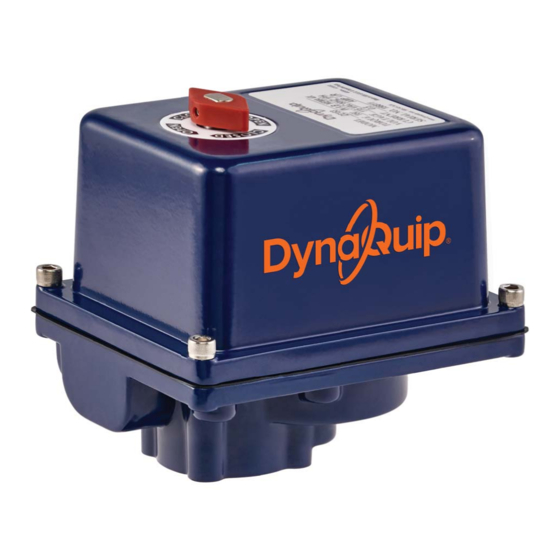DynaQuip EVS Series Instrukcja instalacji, konserwacji i obsługi - Strona 4
Przeglądaj online lub pobierz pdf Instrukcja instalacji, konserwacji i obsługi dla Kontroler DynaQuip EVS Series. DynaQuip EVS Series 12 stron.

Storage
Store in a clean, dry environment and protect from severe temperature changes and vibration.
NOTE: After installation it is the customers responsibility to be certain that all set screws, terminal screws, housing bolts
and mounting bolts are tight, and limit switches, potentiometers and position transmitters are calibrated to the individual
settings required for their specific application.
Troubleshooting
PROBLEM
Power to unit, but does
not operate
Erratic actuator
performance
Low torque output
Incorrect travel
or operation
Safety First
In the maintenance and operation of mechanical equipment, safety is a basic factor that must be considered at all times.
By using proper clothing, tools and procedures, serious accidents to you and your fellow workers can be prevented.
After inspecting the actuator, keep the following information for future reference.
Actuator Model Number
Output Torque
Voltage
Serial Number
Date of Installation
Location
Valve/Line Tag Number
4
CAUSE/CORRECTIVE ACTION
•
Interrupted power. Check for broken or loose wires, blown fuses or tripped breaker.
Check the limit switches to see if they are in the normal operating positions.
•
Motor burnout. Check to insure that correct voltage has been applied. Check all wiring
against installation wiring diagrams.
•
Malfunctioning valve. Check that valve is operating properly.
•
Check the ambient temperature rating. The motor is a permanent split capacitor type
equipped with a thermal cut-out switch. Excessive temperatures and cycle frequencies
may heat the motor up and the thermal cut-out turns off the motor.
•
Check frequency of operation. This electric actuator has a duty rating of 50% (no more
than 30 minutes run time out of every hour).
•
Low voltage "brown out" . Measure line voltage to insure that actuator is receiving full
rated voltage.
•
Motor stall. Check for foreign obstruction in valve. Check for increased torque load due
to line pressure, etc.
•
Low voltage or current. Check to insure that power supply is within listed specifications.
•
Overheating. See erratic actuator performance above.
•
Refer to "Setting Cams For Alignment" in this manual.
•
Circuit not energized for full duration of cycle. Malfunction in control device
(relay, switch, etc.); inspect and correct or replace.
